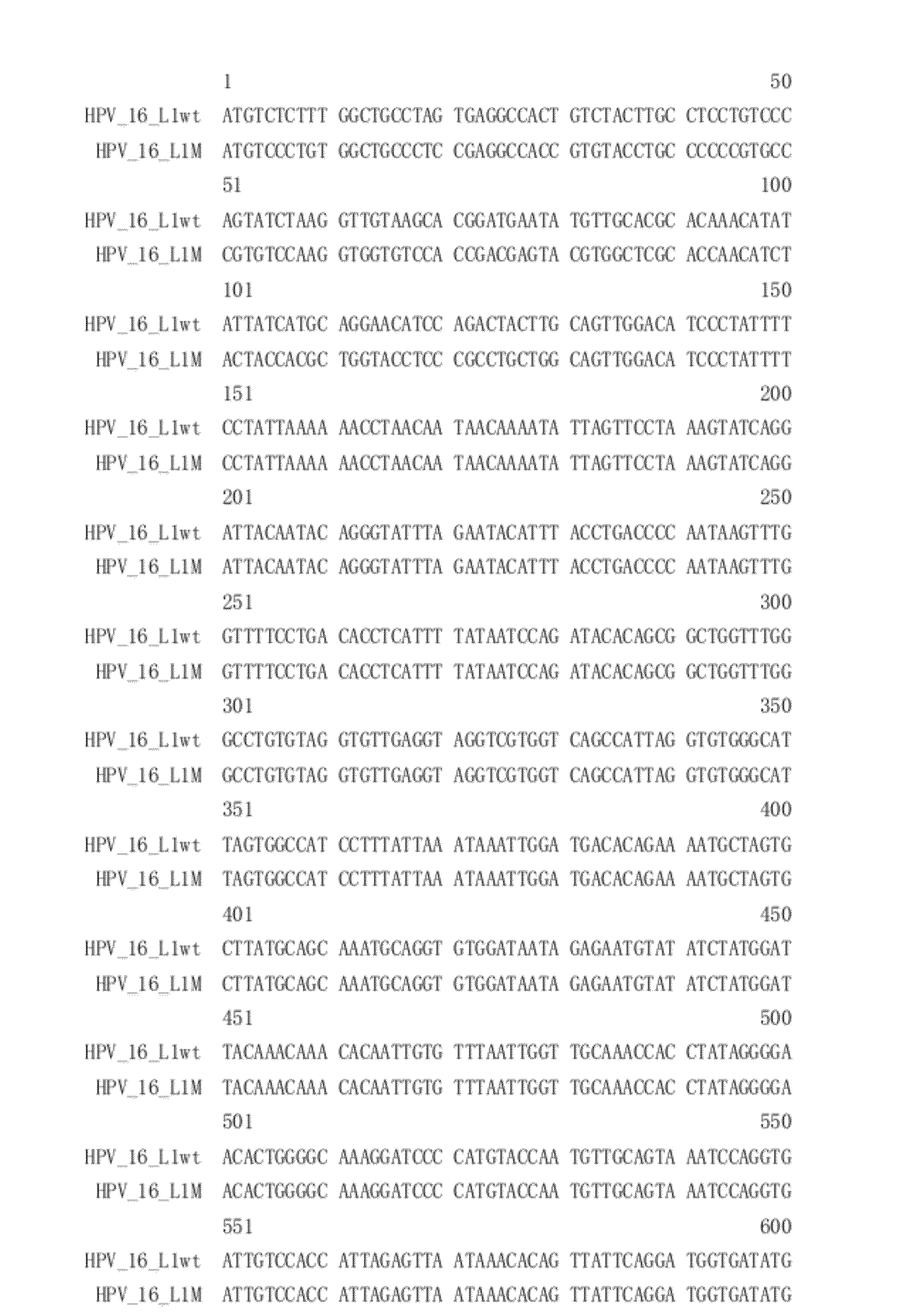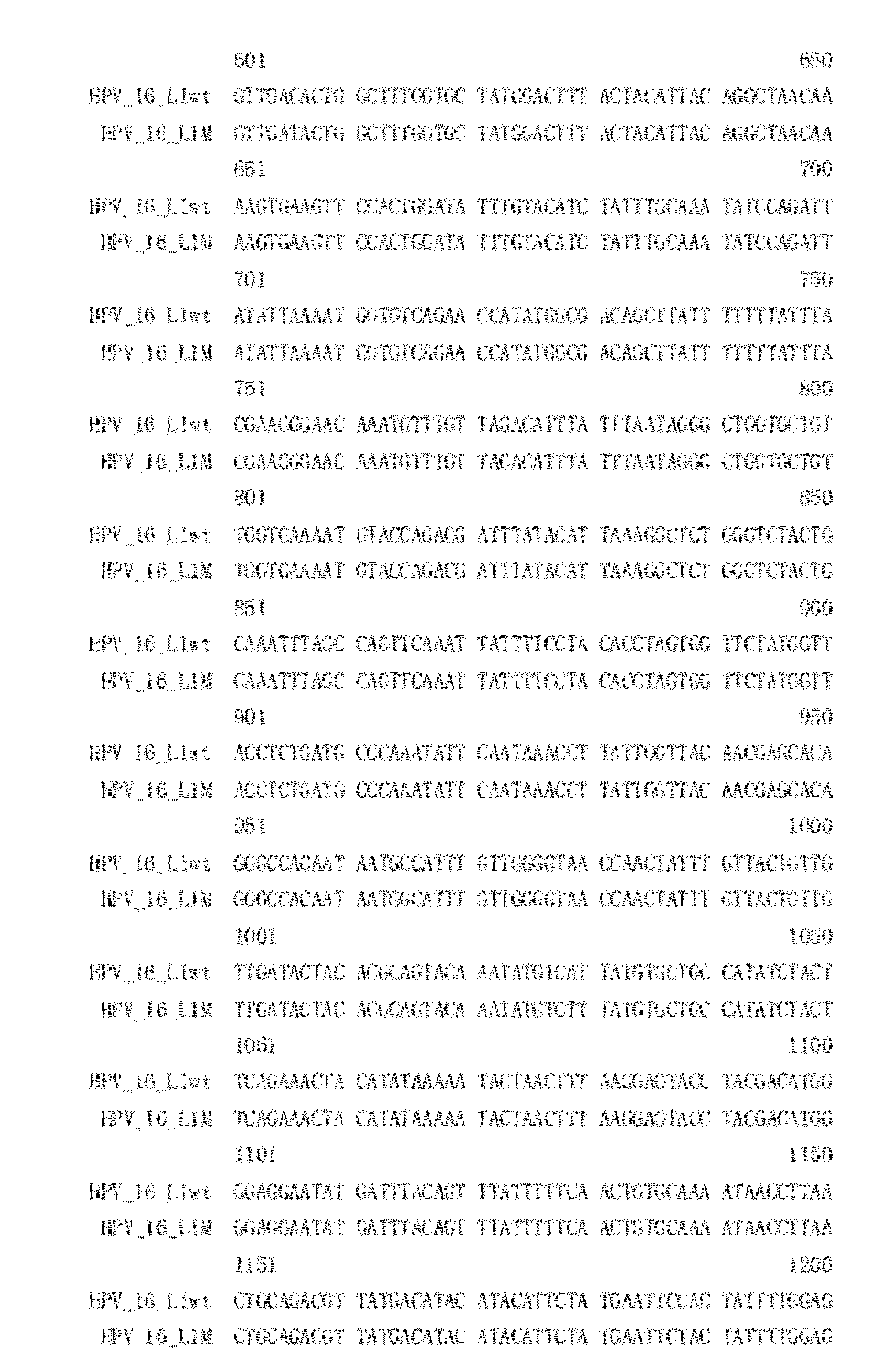Virus-like particles of capsid proteins from human papillomavirus type 16/58/18/6/11 and the method for preparation and the uses thereof
a technology of capsid proteins and viruses, which is applied in the field of human papillomavirus viruslike particles, can solve the problems of limited clinical therapeutics for condyloma acuminate, no effective chinese domestic vaccine, and relatively high cost of pap smear screening for cervical cancer, so as to increase the yield of vlp protein and induce specific humoral and cellular immune responses
- Summary
- Abstract
- Description
- Claims
- Application Information
AI Technical Summary
Benefits of technology
Problems solved by technology
Method used
Image
Examples
example 1
Optimized Modifications of HPV 16, 58, 18, 6 and 11 Major Capsid Protein L1 Genes
[0062]HPV 16, 58, 18, 6 and 11 L1 proteins can be expressed in insect cells by corresponding wild type L1 genes, however, since the expression level of the wild type HPV L1 genes is relatively low, several optimized gene modifications, including codon optimizations, were carried out to increase the HPV L1 protein yield. The modified genes were named LlMs, and were synthesized in full-length by Shanghai Sangon Biological Engineering Technology & Services Co. Lid, China. The insect cell codon usage bias is described in the “codon usage database” (http: / / www.kazusa.or.jp / codon / ). When removing hypothetical splicing donor and receiver regions (such as GGTRAG-like splice donors and C / T-rich splicing receivers), removing hypothetical stop signals (such as the AT rich structures TATATA, TAGATA, and TACATA etc.), removing hnRNP-H binding sites, removing long stems formed by GC pairs in RNA secondary structure a...
example 2
Construction of pFastBacI-HPV 16 L1M, pFastBacI-HPV 58 L1M, pFastBacI-HPV 18 L1M, pFastBacI-HPV 6 L1M and pFastBacI-HPV 11 L1M Recombinant Plasmids
[0069]Upstream and downstream primers containing appropriate restriction sites for amplifying the corresponding L1M genes were designed using standard protocol, based on gene sequences described in Example 1. Corresponding fragments were amplified by PCR and subcloned into pFastBacI vectors at the corresponding multicloning sites. Corresponding recombinant plasmids were obtained and verified by restriction digestion and sequencing.
[0070]Construction of the Modified Human Papillomavirus 16 Major Capsid Protein L1 Gene
[0071]Given that inhibitory elements exist at the 5 prime end of the wild type HPV 16 L1 gene, such inhibitory elements were inactivated in order to increase the expression level of HPV 16 L1 protein. The modified HPV 16 L1 gene was named HPV 16 L1M.
[0072]PCR was conducted using pGEM-T-HPV 16 L1 wt recombinant plasmid as templ...
example 3
Protein Expression Analysis of Modified HPV L1 Genes (by SDS-PAGE with Coomassie Blue Staining or Western Blot)
[0076]5 μg insect cell lysates transfected by each of the recombinant baculoviruses described in Example 2 was collected at 72 h post-infection, denatured at 70° C. for 5 min with final concentration of 10 mmol / L DTT, and separated by 8% SDS-PAGE. The SDS-PAGE gel was then stained with Coomassie blue R-250 at room temperature for 2 h, and destained for several hours until the bands become clearly visible.
[0077]0.5 μg insect cell lysates transfected by each of the recombinant baculoviruses was harvested at 72 h post-infection, denatured at 70° C. for 5 min with final concentration of 10 mmol / L DTT, and separated by 8% SDS-PAGE. The proteins were transferred onto membranes and blocked in 5% BSA at room temperature for 2 h. Primary antibody was added and incubated. After washing the cells, goat anti-rabbit and goat anti-mouse HRP secondary antibodies were added at 1:5000, and ...
PUM
| Property | Measurement | Unit |
|---|---|---|
| temperature | aaaaa | aaaaa |
| diameter | aaaaa | aaaaa |
| pH | aaaaa | aaaaa |
Abstract
Description
Claims
Application Information
 Login to View More
Login to View More - R&D
- Intellectual Property
- Life Sciences
- Materials
- Tech Scout
- Unparalleled Data Quality
- Higher Quality Content
- 60% Fewer Hallucinations
Browse by: Latest US Patents, China's latest patents, Technical Efficacy Thesaurus, Application Domain, Technology Topic, Popular Technical Reports.
© 2025 PatSnap. All rights reserved.Legal|Privacy policy|Modern Slavery Act Transparency Statement|Sitemap|About US| Contact US: help@patsnap.com



